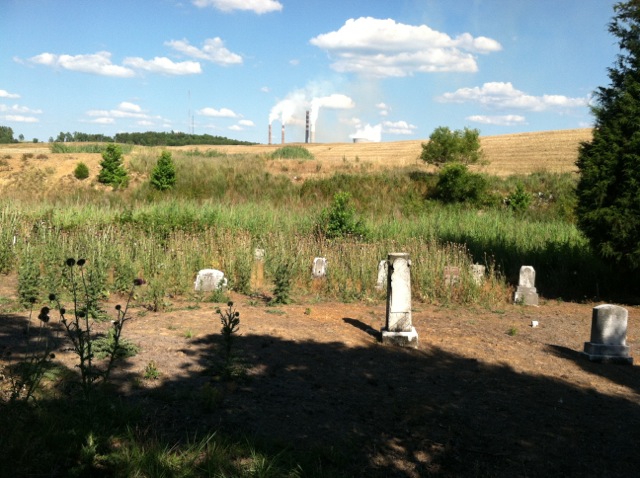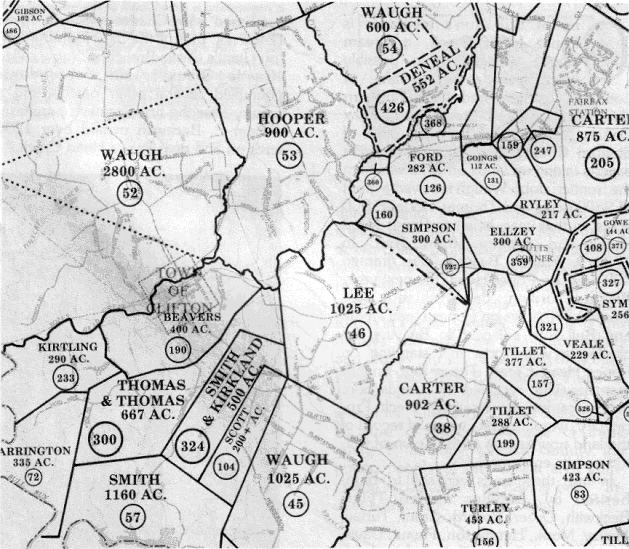The expansion westward, over the top of the Blue Ridge and into the Kentucky wilderness eventually raised hell with the Native population and eventually the environment. The eradication of the Native population to the east of the Mississippi was becoming evident to both tribal nations and white pioneers. Let’s not pretend the hate filled words, “The only good Indian is a dead Indian,” were never uttered. And let’s not pretend that those who pose as American leaders today don’t posture in the same vein when they preach the need to build walls to keep the folks from Mexico out, and prevent Syrians and Moslems, in general, from entering in.
In related stories we will look at our own family members encounters with a variety of Native populations and British loyalists in the Ohio River Valley. We will also see the immediate impact of the Industrial Revolution on the quality of life of our ancestors who were so enthralled that they called their new homeland ‘Paradise’. Issues related to the environment would sneak up on our ancestors and bite them and the nation in the butt.
Jemima Kincheloe Simpson Smith
That name alone, to my way of thinking, is a lot of names wrapped up in one person’s home address: Jemima Kincheloe Simpson Smith. That is a ton of letters to pen across an envelop back in the day when people sent Christmas cards. The old nib on the quill would need replacing before one got to the last ‘h’ in Smith. What becomes interesting, in a mildly inane, pedantic sort of way, is the jig saw manner in which names got tossed about and added to a child as they went from the cradle to the grave. The rules for naming a child do not seem to be as firm and fast as they were for Dutch families or the households of Swedes to the North on Delaware River. Just when I think I understand the pattern my British forefathers used for naming a child I get stumped by ‘grandmothers’ like Jemima Kincheloe Simpson Smith or Elizabeth Presley Tayloe Smith Landman or is it ‘Lamman’. They throw a monkey wrench or better yet, a butter churn, into the works and I throw what I think I know into the circular file.
In the case of Jemima Kincheloe Simpson Smith, I cannot find that she had a parent or grandparent or even a great grandparent with the surname ‘Kincheloe’. There are Kincheloes in our family tree. So where did that come from? I browsed through her young life looking for a previous marriage to either a Kincheloe or a Simpson. Or a name she picked up as a dancer in a joint down on the boardwalk. I have seen enough evidence to establish the fact that she was born a Simpson, the daughter of George Simpson and Susannah Wheeler. Jemima was a fifth generation ‘American,’ before there was an America, in the year of her birth, 1743. Think of that: 5th generation in 1743! The immigrant ancestor, John Sympson, was born (1620) a Scot. His ancestors trace back to Falkirk, Stirlingshire, Scotland and the Isle of Wight. John died a Virginian (1698) in Alexandria VA. While the records are hard to find, legend has it that he brought the game of golf to Virginia. Plans to purchase Myrtle Beach in the Carolinas were found in his desk drawer along with schematics that would lead to the development of titanium shafts and large heads on drivers. Okay, you know me well enough to spot a lie amongst all this research. I am sorry, but a guy does have to shake the need to be anal retentive when writing all this “family fact” stuff.
John’s son, John “The Scot” Simpson, was a well known, rugged frontiersman, also born in Scotland (1645) and raised early on in Virginia. He settled into the Aquia Creek area of present day Stafford County where he died (1709).
John The Immigrant father, married Mary Withers who was born in the colonies in 1634. John (Jr) The Scot married Mary Thompson, a daughter of Henry Thompson and Jane Newton. Henry was a second generation colonist also born in Virginia (1629). He was here when the whole colonial dynamic was going through infancy right along with him. The chances for survival for the colony and Henry were minimal. Henry’s wife Jane was a Yorkshire, England gal, who was born in Yorkshire and died there. In such instances I find a pattern that runs true in many cases with both men and women. It was one thing to make the trip over here and live the life of a rugged pioneer. It was quite another to gut it out and die here. Men and women often returned to the homeland to live out their days in a more genteel manner. The death of a spouse tended to trigger one of two reactions: either return to England or 2) remarry almost immediately.
Henry Thompson was born and died on the Willow Sprout Plantation. Both the Thompson and Newton names appear often in the early deed books of the Virginia Commonwealth and they reoccur in our family tree as cousins, uncles and aunts, etc.
Jemima Simpson’s parents and relatives owned properties in the neighborhood of the Bull Run properties purchased first by Peter (of Westmoreland) Smith in 1712. Bull Run feeds into the Occuquan, before it hits the Potomoc River. Looking at the map one can see several Simpson properties (deeds 160, 83) near Smith lands (deeds 57, 324).
In the 1600s, John The Scot’s property on Aquia Creek was five miles south of the Smith properties on Chopawamsic Creek and a little to the north of their homeland grounds on the Nominy River.
Jemima’s maternal side of her tree had just as many well established colonists as her paternal roots: the Wheelers, Frizzells, Gales, Drummonds and Stewarts were well established in Anne Arundel County, Maryland in the 1600’s. As Maryland was established as a refuge for Catholic families it is easy to surmise that they were Roman Catholic. That would not be necessarily true for each family. Maryland’s owner/operator Lord Baltimore got a rush out of establishing a colony that provided religious freedom and opened the door to people of all Christian faiths. The rise of Maryland as an economic and political force created problems for Smiths and Whittingtons in Westmoreland and Accomack Counties. Religious differences created unrest and rebellion and forced a number of Peter Smith’s neighbors to flee west across the Potomoc to Westmoreland. So, in a manner of speaking, Jemima’s family history was a microcosm of Virginia Colonial history in a nutshell.
When Jemima and Peter Smith packed it up (c. 1775) and left the coastal plains for the Piedmont and Round Hill, they joined a migration of folks who were beginning the press westward. The expansion of the British colony was underway. Scots, Irish, Welsh and Brits were pushing down from the north on the Great Wagon Road and in from the east as Peter Smith did on the way to Round Hill in Caswell County. They were joined by Germans and French seeking a new life.
The seven cousins of Round Hill Peter Smith headed south from Bull Run and established Spartanburg, South Carolina. Those cousins were the sons of Thomas Smith, brother of my grrrrreat grandfather James. The seven sons of Thomas included: Charles, Fleming, Daniel, James, Thomas, Peter and John. They were hatched between the years 1745 and 1755 and the entire brood had landed at various times in Spartanburg in c. 1775, according to the History of Spartanburg, SC. This does not, by any means, imply that they stayed put. The American Revolutionary War was about to explode upon the scene. The men would live through the experience, acquiring various ranks in the military and the pension papers necessary to prove their entitlement to whatever small pension the newly formed government could provide. The war did force several to relocate in the aftermath.
William Smith (b. 1795) son of Peter of Westmoreland and oldest brother of our James and Uncle Thomas, married Letitia Hancock (b. 1712), the daughter of John Hancock (b. 1740) and Katherine Smith. No, not thee John Hancock of Boston, Mass and liberty fame. Letitia and William had several children: 1) son Hancock Jr married Jane Meaders and they pretty much stayed put in Halifax, Virginia. 2) son James (b. 1748) married Jane Ross and 3) son William, of whom little is known. James joined the seven sons of Thomas in Spartanburg. Together, they formed a Rock Band, The Seven Sons of Thomas, and played the Holiday Inn circuit, landing gigs in Spartanburg and Atlanta, Georgia. Okay… I flipped out again… I got hooked on that name: The Seven Sons of Thomas. In real life James did join his cousins in Spartanburg and lived out his life there, with wife Jane, dying in Cedar Springs, SC in 1807.
It is entirely possible that historians and genealogists have confused the James Smith cousins at this point in history and I don’t want to lend further to that. Let me say, that if I had more time and if I were descended from a James Smith of Spartanburg SC (1775) I would want to check the credentials of the two that we have reported as being there together (James, son of Thomas and James, son of William). Were there in fact two men, cousins of the the same first name present in Spartanburg? It does make the point that is made frequently in family histories from Colonial America: cousins tended to migrate in a pack.
But it also may make a second point. I can’t stress enough the weakness of many online trees and the tendency that hurried tree builders have: they throw what we call ‘orphans’ into any available tree (of the surname) that might be available within 800 miles and one hundred years. An ‘orphan’ in tree building is a person for whom we cannot find the parents. It may also be a person for whom we can find no, parents, siblings, mate, children, etc.
I sometimes picture a film, a movie in which a lazy genealogist unwittingly reverses the lives of folks, four hundred years ago, by throwing them into the wrong family tree. Picture the following: Some frustrated tree builder, dressed in house coat and slippers, surrounded by bon-bons and macaroons, sitting at a computer in 2016, frustrated by the inability to locate Peter Smith’s father, assigns him to Robert Smith, Maryland Privateer in 1648. Flash back four hundred years and the actual Peter Smith, who was sunning himself in a field of tobacco, is suddenly thrust onto his newly assigned father’s ship heading to Bermuda with guns pointed at an approaching Dutch warship. Imagine the chaos one could create if they had such power. Kind of like the Terminator minus the steroids.
Back to our Smith clan.
Round Hill Peter’s brother, Bailey Smith, would join Peter briefly before hooking up with Daniel Boone and Richard Henderson, in Henderson’s not quite legal (extra legal), okay… mostly illegal attempt to establish a Transylvania Colony where Kentucky and Tennessee now stand. Round Hill Peter’s Smith family and Jemima’s Simpson family would soon follow Bailey beyond the Blue Ridge. Peter and Jemima would stay put in Caswell County, running their plantation and monitoring the progress of their slaves and servants.



